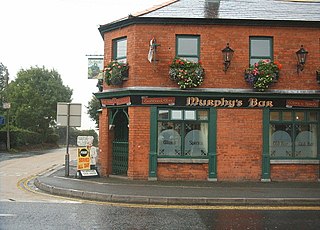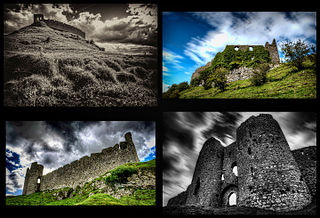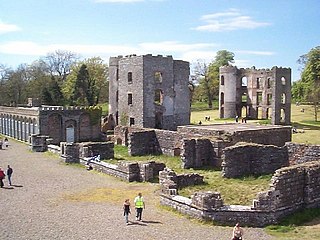Related Research Articles

Clough is a village and townland in County Down, Northern Ireland. It sits about 3 miles from Dundrum on the A2 between Newcastle and Belfast. The A2 continues via Downpatrick and the coast via Strangford and the Portaferry – Strangford Ferry to Portaferry to Belfast, whilst most road traffic heads along from Clough along the A24 via Carryduff to Belfast. It had a population of 255 people in the 2001 census. Clough is situated within the Newry, Mourne and Down area.

Rossmore Castle, also known as Rossmore Park, was a castle on the outskirts of Monaghan in County Monaghan, Ireland. It was built in the Gothic style in 1827 and was the seat of the Barons Rossmore, but fell into disrepair in the 1940s when the family moved to Camla Vale, and was demolished in the 1970s.

Gosford Castle is a 19th-century country house situated in Gosford, a townland of Markethill, County Armagh, Northern Ireland. It was built for Archibald Acheson, 2nd Earl of Gosford, and designed in the Norman revival style by London architect Thomas Hopper. It is a Grade A listed building, and is said to be Ulster's largest. The Earls of Gosford occupied the castle until 1921, and the estate was later purchased by the Ministry of Agriculture to form Gosford Forest Park. The building subsequently deteriorated and in 2006 was sold to a development company who converted the castle into private dwellings.

Donegal Castle is a castle situated in the centre of Donegal Town in County Donegal in Ulster, the northern province in Ireland. The castle was the stronghold of the O'Donnell clan, Lords of Tír Conaill and one of the most powerful Gaelic families in Ireland from the 5th to the 16th centuries. For most of the last two centuries, the majority of the buildings lay in ruins but the castle was almost fully restored in the early 1990s. It is now open to the public.
Creevekeeran Castle is a castle in County Armagh, Northern Ireland. It stands on a rocky outcrop but only the west wall, three stories high, remains. The castle is a Scheduled Historic Monument sited in the townland of Creevekeeran, in the Armagh City, Banbridge and Craigavon Borough Council area, at grid ref: H7847 3710.

Greencastle is a castle in County Down, Northern Ireland. While it dates mainly from the 13th century, it had substantial 15th- and 16th-century alterations. It was originally surrounded by outer rectangular walls with four corner towers. It is likely to have been built by Hugh de Lacy, along with Carlingford Castle on the opposite side of Carlingford Lough, to guard the narrow entry channel to the Lough, and the ferry crossing between the two.

Meigh is a small village and townland near Slieve Gullion in County Armagh, Northern Ireland. It had a population of 444 people in the 2001 Census. It lies within the Newry, Mourne and Down District Council area.

Castle Leslie, also known as Glaslough House, is home to an Irish branch of Clan Leslie, is located on the 4 km2 (1,000-acre) Castle Leslie Estate adjacent to the village of Glaslough, 11 km (7 mi) northeast of Monaghan town in County Monaghan, Ireland.

Brockagh is a village in County Tyrone, Northern Ireland. It is on the western shore of Lough Neagh, about 7 kilometres (4.3 mi) east of Coalisland and north of Washing Bay. It lies within the Mid Ulster District Council area.

Tandragee Castle, Tandragee, County Armagh, Northern Ireland, was built in 1837 by the 6th Duke of Manchester as the family's Irish home. The Duke of Manchester acquired the estate through his marriage to Millicent Sparrow (1798–1848).

Altinaghree Castle or Liscloon House, known locally as Ogilby's Castle, is a large, derelict building situated outside Donemana, County Tyrone, Northern Ireland. It is believed to have been built around 1860 by William Ogilby.

Castle Roche is a Norman castle located some 10 km north-west of Dundalk, County Louth, Ireland. It was the seat of the de Verdun family, who built the castle in 1236 AD.

Galgorm is a townland in County Antrim, Northern Ireland, about 1 km west of Ballymena. It is part of the civil parish of Ahoghill. Administratively, it is in the Borough of Ballymena.

Ringhaddy is a townland on the shores of Strangford Lough, County Down, Northern Ireland, 5 km south of Whiterock. It is in the civil parish of Killinchy and the historic barony of Dufferin.

Shane's Castle is a ruined castle near Antrim in County Antrim, Northern Ireland, which was mostly destroyed in 1816 by fire. The castle is situated on the north-east shores of Lough Neagh, 2.7 miles from Randalstown. Built in 1345 by a member of the Clandeboy O'Neill dynasty, it was originally known as Edenduffcarrick, meaning "brow of black rock". It owes its present name to Shane McBrian McPhelim O'Neill, who ruled Lower Clandeboy between 1595 and 1617.

Rose Castle is a fortified house in the parish of Dalston, Cumbria, England. It was the residence of the bishops of Carlisle from 1230 to 2009, and has been a peace and reconciliation centre since it was sold by the Church Commissioners to the Rose Castle Foundation in 2016. The castle is a grade I listed building.
Twescard is a former county of the Earldom of Ulster in medieval Ireland. Taking its name from the native Irish territory of in Tuaiscirt, it spanned the northern coastland of County Antrim and County Londonderry. At its height it stretched from Glenarm in the east of the Glens of Antrim to Inishowen in modern County Donegal. It was conquered and settled by Hugh de Lacy and was centered on Coleraine and the lower Bush valley. By the 1460s, the de Mandevilles abandoned and sold their remaining lands in Twescard to the McQuillans who renamed the territory the Route.
Kirkcudbright Castle, was a castle that was located on the banks of the River Dee, in Kirkcudbright, Scotland.

Ballyroney railway station was on the Great Northern Railway (Ireland) which ran from Banbridge to Castlewellan in Northern Ireland.

Richhill Castle is a 17th-century Grade A listed country house in the large village of Richhill, in the townland of Legacorry, Armagh, Northern Ireland, roughly halfway between Armagh and Portadown.
References
- Bardon, Jonathan, A History of Ulster. The Black Staff Press, 2005. ISBN 0-85640-764-X